Operations Management and Quality in Cruise International Inc. Report
VerifiedAdded on 2022/05/20
|10
|2690
|27
Report
AI Summary
This report provides an in-depth analysis of Supply Chain Management (SCM) and quality operations within Cruise International Inc. It begins with an introduction to SCM and its crucial conceptions, emphasizing its importance in delivering services and products efficiently. The report then explores SCM in a service operation context, focusing on the cruise industry and its various supply chain elements, including suppliers of ships, food, and information systems. A significant portion of the report discusses the benefits of partnering with suppliers, highlighting the importance of trust, transparency, and joint problem-solving. Potential conflicts of interest within the supply chain, such as gifts, personal relationships, and resource misuse, are also addressed. Finally, the report outlines reporting procedures for conflicts of interest and concludes by emphasizing the significance of SCM in coordinating activities and ensuring customer satisfaction, particularly within the dynamic cruise industry. The report references various academic sources to support its analysis and recommendations.
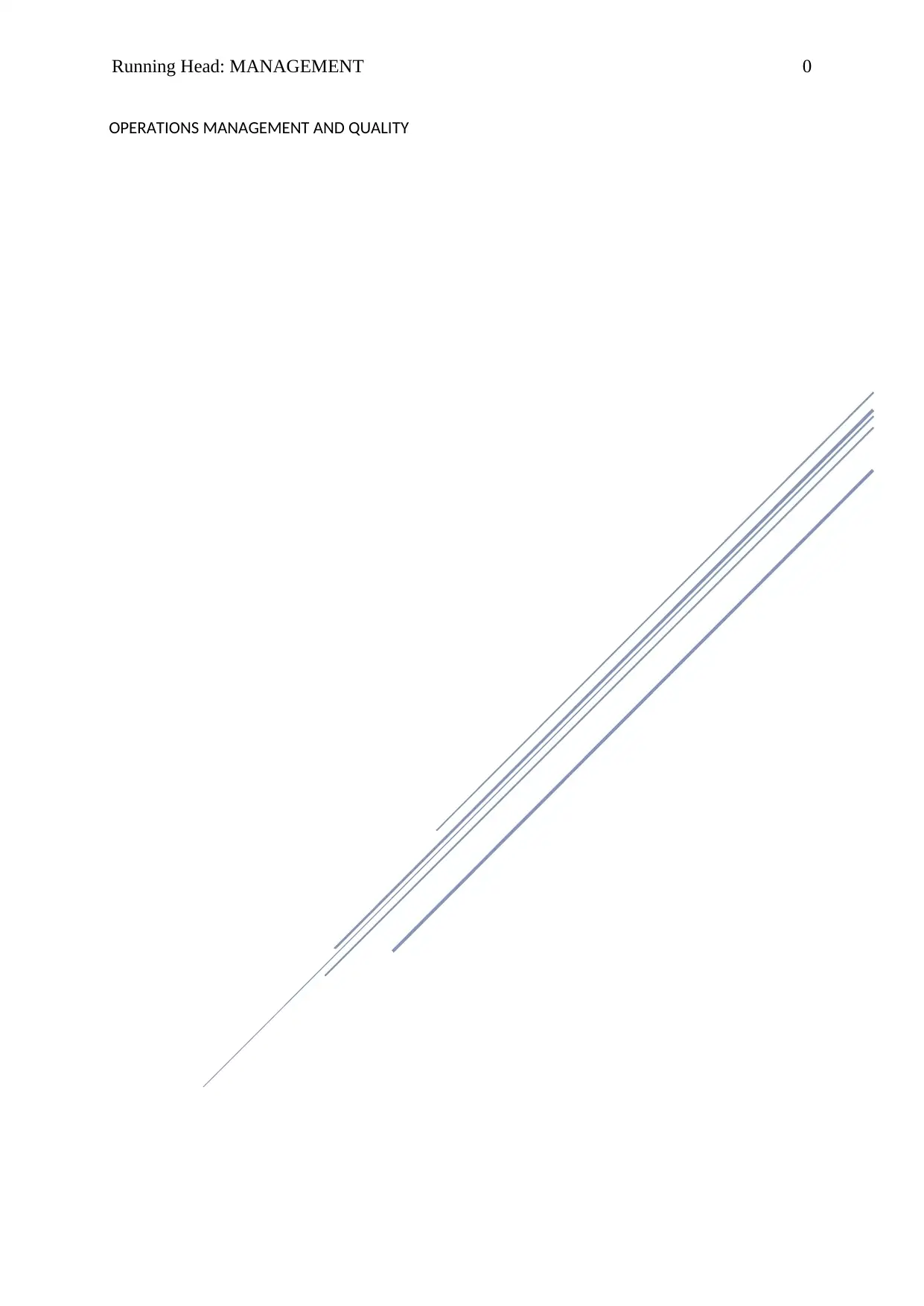
Running Head: MANAGEMENT 0
OPERATIONS MANAGEMENT AND QUALITY
OPERATIONS MANAGEMENT AND QUALITY
Paraphrase This Document
Need a fresh take? Get an instant paraphrase of this document with our AI Paraphraser
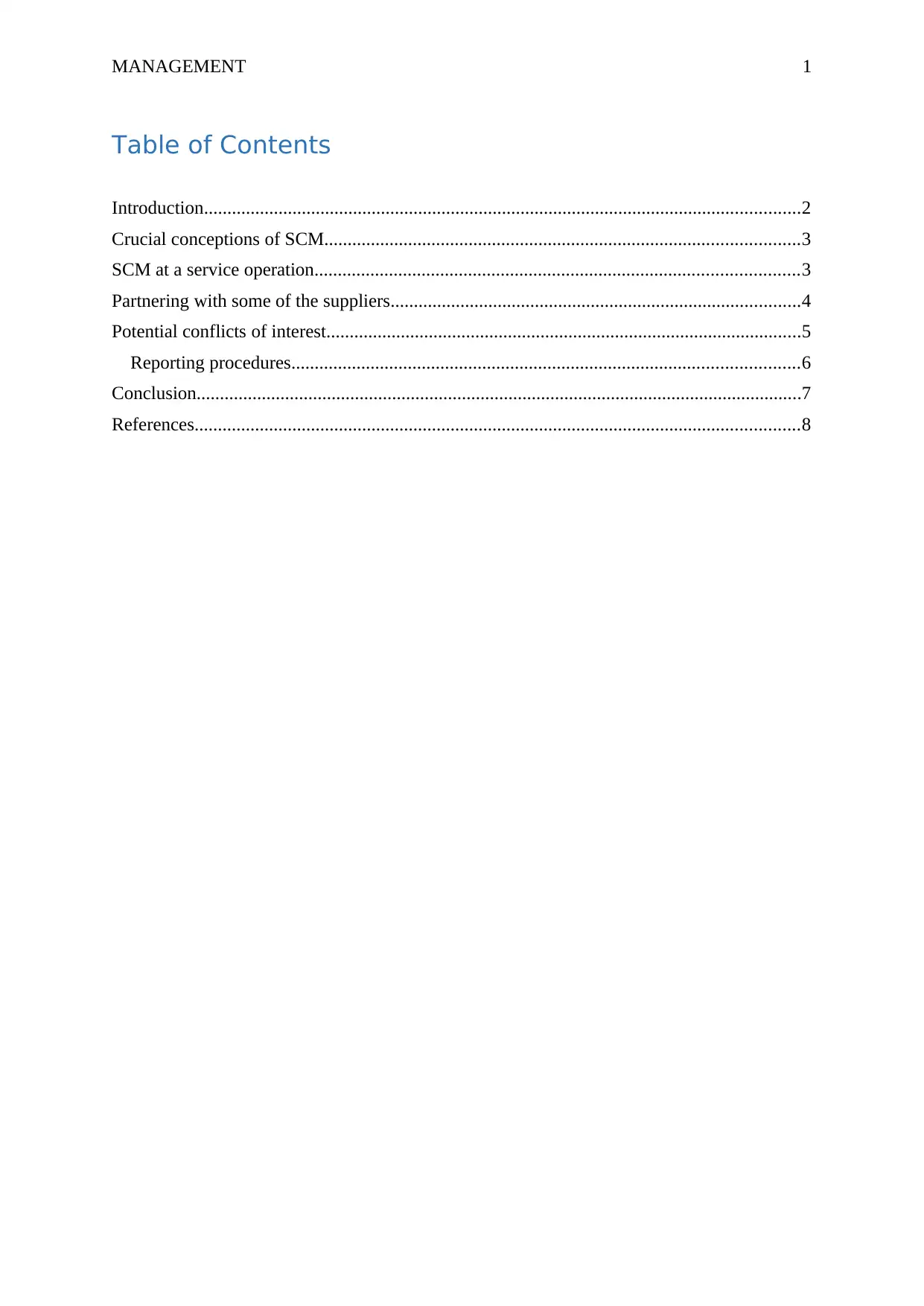
MANAGEMENT 1
Table of Contents
Introduction................................................................................................................................2
Crucial conceptions of SCM......................................................................................................3
SCM at a service operation........................................................................................................3
Partnering with some of the suppliers........................................................................................4
Potential conflicts of interest......................................................................................................5
Reporting procedures.............................................................................................................6
Conclusion..................................................................................................................................7
References..................................................................................................................................8
Table of Contents
Introduction................................................................................................................................2
Crucial conceptions of SCM......................................................................................................3
SCM at a service operation........................................................................................................3
Partnering with some of the suppliers........................................................................................4
Potential conflicts of interest......................................................................................................5
Reporting procedures.............................................................................................................6
Conclusion..................................................................................................................................7
References..................................................................................................................................8
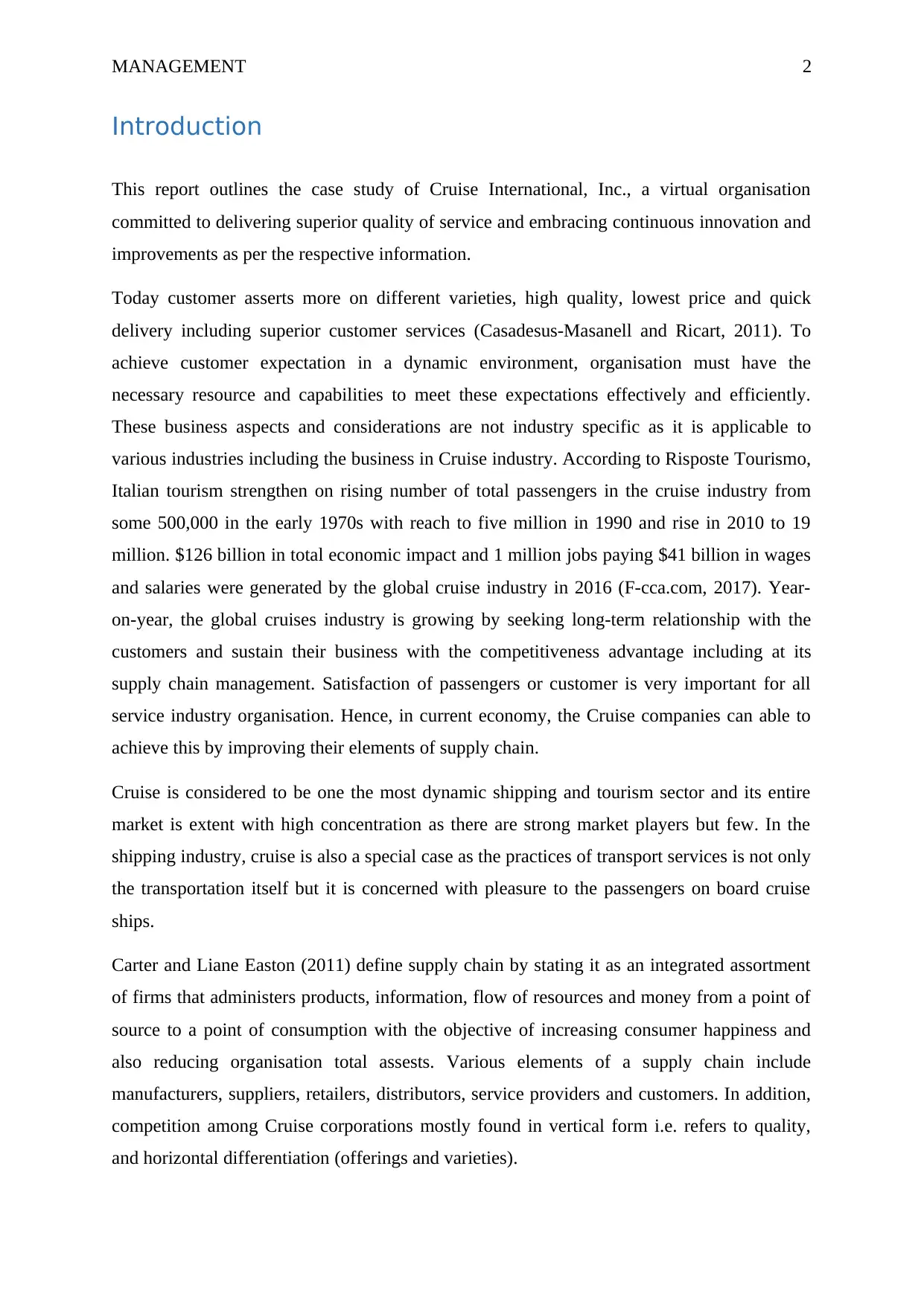
MANAGEMENT 2
Introduction
This report outlines the case study of Cruise International, Inc., a virtual organisation
committed to delivering superior quality of service and embracing continuous innovation and
improvements as per the respective information.
Today customer asserts more on different varieties, high quality, lowest price and quick
delivery including superior customer services (Casadesus-Masanell and Ricart, 2011). To
achieve customer expectation in a dynamic environment, organisation must have the
necessary resource and capabilities to meet these expectations effectively and efficiently.
These business aspects and considerations are not industry specific as it is applicable to
various industries including the business in Cruise industry. According to Risposte Tourismo,
Italian tourism strengthen on rising number of total passengers in the cruise industry from
some 500,000 in the early 1970s with reach to five million in 1990 and rise in 2010 to 19
million. $126 billion in total economic impact and 1 million jobs paying $41 billion in wages
and salaries were generated by the global cruise industry in 2016 (F-cca.com, 2017). Year-
on-year, the global cruises industry is growing by seeking long-term relationship with the
customers and sustain their business with the competitiveness advantage including at its
supply chain management. Satisfaction of passengers or customer is very important for all
service industry organisation. Hence, in current economy, the Cruise companies can able to
achieve this by improving their elements of supply chain.
Cruise is considered to be one the most dynamic shipping and tourism sector and its entire
market is extent with high concentration as there are strong market players but few. In the
shipping industry, cruise is also a special case as the practices of transport services is not only
the transportation itself but it is concerned with pleasure to the passengers on board cruise
ships.
Carter and Liane Easton (2011) define supply chain by stating it as an integrated assortment
of firms that administers products, information, flow of resources and money from a point of
source to a point of consumption with the objective of increasing consumer happiness and
also reducing organisation total assests. Various elements of a supply chain include
manufacturers, suppliers, retailers, distributors, service providers and customers. In addition,
competition among Cruise corporations mostly found in vertical form i.e. refers to quality,
and horizontal differentiation (offerings and varieties).
Introduction
This report outlines the case study of Cruise International, Inc., a virtual organisation
committed to delivering superior quality of service and embracing continuous innovation and
improvements as per the respective information.
Today customer asserts more on different varieties, high quality, lowest price and quick
delivery including superior customer services (Casadesus-Masanell and Ricart, 2011). To
achieve customer expectation in a dynamic environment, organisation must have the
necessary resource and capabilities to meet these expectations effectively and efficiently.
These business aspects and considerations are not industry specific as it is applicable to
various industries including the business in Cruise industry. According to Risposte Tourismo,
Italian tourism strengthen on rising number of total passengers in the cruise industry from
some 500,000 in the early 1970s with reach to five million in 1990 and rise in 2010 to 19
million. $126 billion in total economic impact and 1 million jobs paying $41 billion in wages
and salaries were generated by the global cruise industry in 2016 (F-cca.com, 2017). Year-
on-year, the global cruises industry is growing by seeking long-term relationship with the
customers and sustain their business with the competitiveness advantage including at its
supply chain management. Satisfaction of passengers or customer is very important for all
service industry organisation. Hence, in current economy, the Cruise companies can able to
achieve this by improving their elements of supply chain.
Cruise is considered to be one the most dynamic shipping and tourism sector and its entire
market is extent with high concentration as there are strong market players but few. In the
shipping industry, cruise is also a special case as the practices of transport services is not only
the transportation itself but it is concerned with pleasure to the passengers on board cruise
ships.
Carter and Liane Easton (2011) define supply chain by stating it as an integrated assortment
of firms that administers products, information, flow of resources and money from a point of
source to a point of consumption with the objective of increasing consumer happiness and
also reducing organisation total assests. Various elements of a supply chain include
manufacturers, suppliers, retailers, distributors, service providers and customers. In addition,
competition among Cruise corporations mostly found in vertical form i.e. refers to quality,
and horizontal differentiation (offerings and varieties).
⊘ This is a preview!⊘
Do you want full access?
Subscribe today to unlock all pages.

Trusted by 1+ million students worldwide
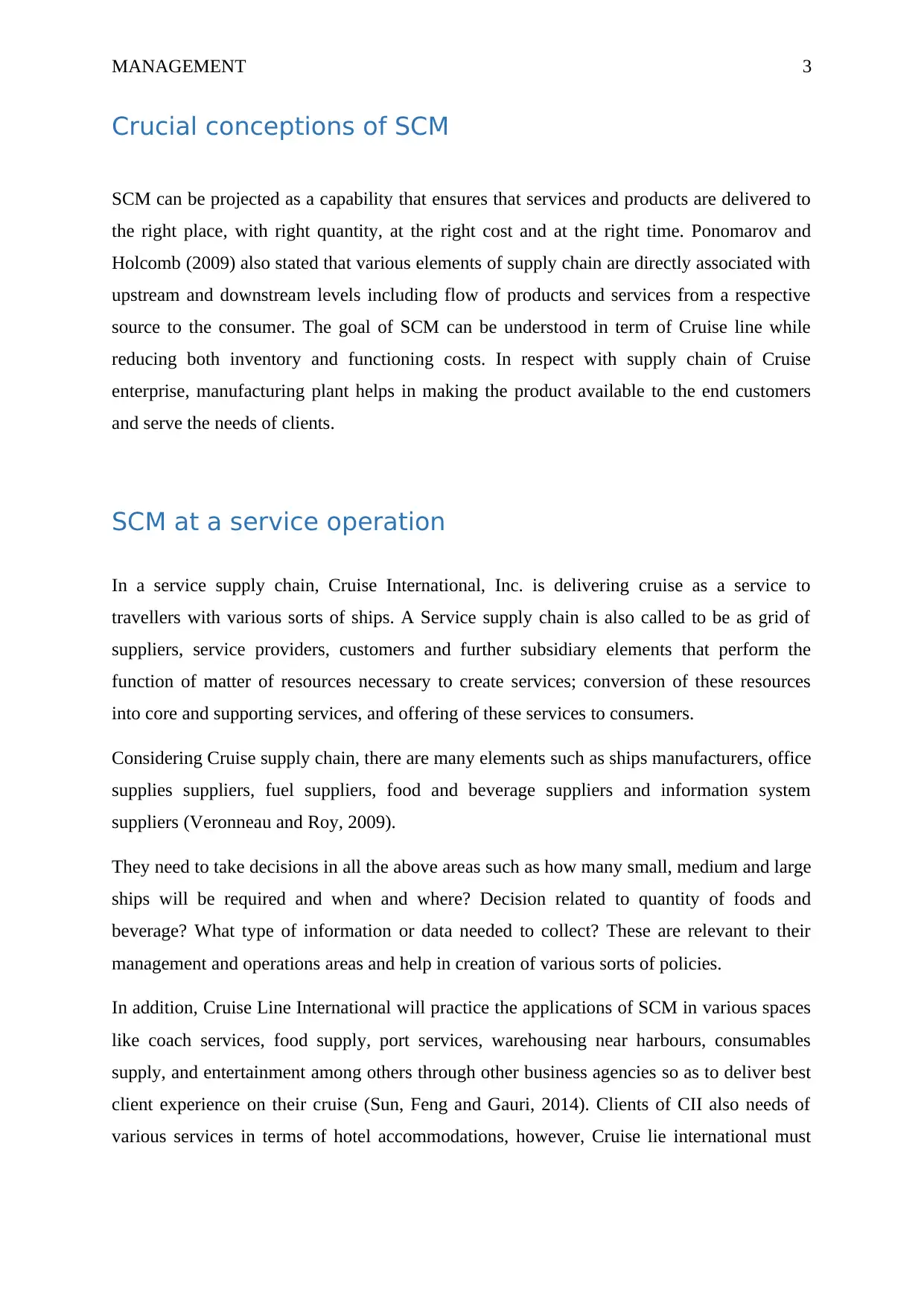
MANAGEMENT 3
Crucial conceptions of SCM
SCM can be projected as a capability that ensures that services and products are delivered to
the right place, with right quantity, at the right cost and at the right time. Ponomarov and
Holcomb (2009) also stated that various elements of supply chain are directly associated with
upstream and downstream levels including flow of products and services from a respective
source to the consumer. The goal of SCM can be understood in term of Cruise line while
reducing both inventory and functioning costs. In respect with supply chain of Cruise
enterprise, manufacturing plant helps in making the product available to the end customers
and serve the needs of clients.
SCM at a service operation
In a service supply chain, Cruise International, Inc. is delivering cruise as a service to
travellers with various sorts of ships. A Service supply chain is also called to be as grid of
suppliers, service providers, customers and further subsidiary elements that perform the
function of matter of resources necessary to create services; conversion of these resources
into core and supporting services, and offering of these services to consumers.
Considering Cruise supply chain, there are many elements such as ships manufacturers, office
supplies suppliers, fuel suppliers, food and beverage suppliers and information system
suppliers (Veronneau and Roy, 2009).
They need to take decisions in all the above areas such as how many small, medium and large
ships will be required and when and where? Decision related to quantity of foods and
beverage? What type of information or data needed to collect? These are relevant to their
management and operations areas and help in creation of various sorts of policies.
In addition, Cruise Line International will practice the applications of SCM in various spaces
like coach services, food supply, port services, warehousing near harbours, consumables
supply, and entertainment among others through other business agencies so as to deliver best
client experience on their cruise (Sun, Feng and Gauri, 2014). Clients of CII also needs of
various services in terms of hotel accommodations, however, Cruise lie international must
Crucial conceptions of SCM
SCM can be projected as a capability that ensures that services and products are delivered to
the right place, with right quantity, at the right cost and at the right time. Ponomarov and
Holcomb (2009) also stated that various elements of supply chain are directly associated with
upstream and downstream levels including flow of products and services from a respective
source to the consumer. The goal of SCM can be understood in term of Cruise line while
reducing both inventory and functioning costs. In respect with supply chain of Cruise
enterprise, manufacturing plant helps in making the product available to the end customers
and serve the needs of clients.
SCM at a service operation
In a service supply chain, Cruise International, Inc. is delivering cruise as a service to
travellers with various sorts of ships. A Service supply chain is also called to be as grid of
suppliers, service providers, customers and further subsidiary elements that perform the
function of matter of resources necessary to create services; conversion of these resources
into core and supporting services, and offering of these services to consumers.
Considering Cruise supply chain, there are many elements such as ships manufacturers, office
supplies suppliers, fuel suppliers, food and beverage suppliers and information system
suppliers (Veronneau and Roy, 2009).
They need to take decisions in all the above areas such as how many small, medium and large
ships will be required and when and where? Decision related to quantity of foods and
beverage? What type of information or data needed to collect? These are relevant to their
management and operations areas and help in creation of various sorts of policies.
In addition, Cruise Line International will practice the applications of SCM in various spaces
like coach services, food supply, port services, warehousing near harbours, consumables
supply, and entertainment among others through other business agencies so as to deliver best
client experience on their cruise (Sun, Feng and Gauri, 2014). Clients of CII also needs of
various services in terms of hotel accommodations, however, Cruise lie international must
Paraphrase This Document
Need a fresh take? Get an instant paraphrase of this document with our AI Paraphraser
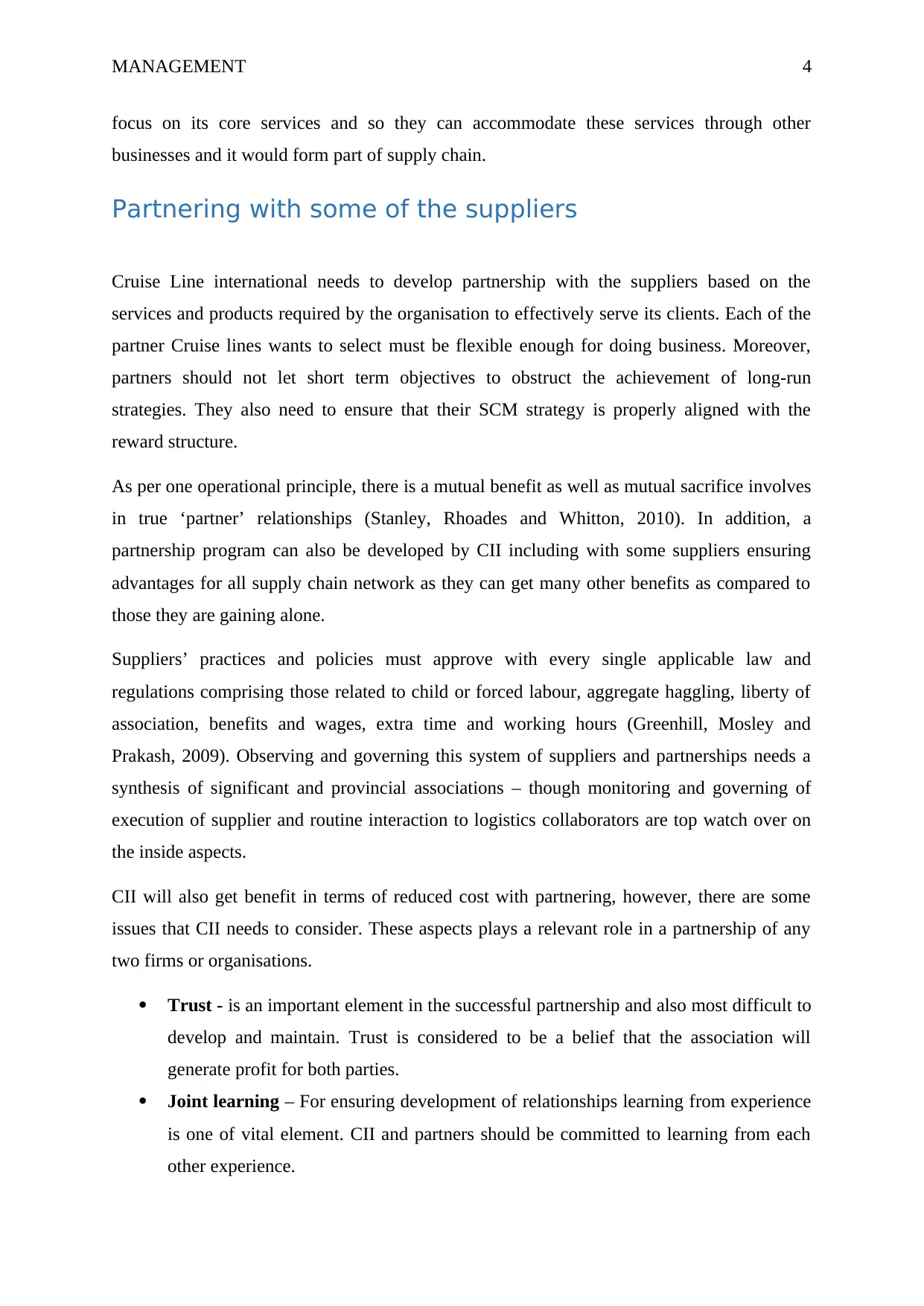
MANAGEMENT 4
focus on its core services and so they can accommodate these services through other
businesses and it would form part of supply chain.
Partnering with some of the suppliers
Cruise Line international needs to develop partnership with the suppliers based on the
services and products required by the organisation to effectively serve its clients. Each of the
partner Cruise lines wants to select must be flexible enough for doing business. Moreover,
partners should not let short term objectives to obstruct the achievement of long-run
strategies. They also need to ensure that their SCM strategy is properly aligned with the
reward structure.
As per one operational principle, there is a mutual benefit as well as mutual sacrifice involves
in true ‘partner’ relationships (Stanley, Rhoades and Whitton, 2010). In addition, a
partnership program can also be developed by CII including with some suppliers ensuring
advantages for all supply chain network as they can get many other benefits as compared to
those they are gaining alone.
Suppliers’ practices and policies must approve with every single applicable law and
regulations comprising those related to child or forced labour, aggregate haggling, liberty of
association, benefits and wages, extra time and working hours (Greenhill, Mosley and
Prakash, 2009). Observing and governing this system of suppliers and partnerships needs a
synthesis of significant and provincial associations – though monitoring and governing of
execution of supplier and routine interaction to logistics collaborators are top watch over on
the inside aspects.
CII will also get benefit in terms of reduced cost with partnering, however, there are some
issues that CII needs to consider. These aspects plays a relevant role in a partnership of any
two firms or organisations.
Trust - is an important element in the successful partnership and also most difficult to
develop and maintain. Trust is considered to be a belief that the association will
generate profit for both parties.
Joint learning – For ensuring development of relationships learning from experience
is one of vital element. CII and partners should be committed to learning from each
other experience.
focus on its core services and so they can accommodate these services through other
businesses and it would form part of supply chain.
Partnering with some of the suppliers
Cruise Line international needs to develop partnership with the suppliers based on the
services and products required by the organisation to effectively serve its clients. Each of the
partner Cruise lines wants to select must be flexible enough for doing business. Moreover,
partners should not let short term objectives to obstruct the achievement of long-run
strategies. They also need to ensure that their SCM strategy is properly aligned with the
reward structure.
As per one operational principle, there is a mutual benefit as well as mutual sacrifice involves
in true ‘partner’ relationships (Stanley, Rhoades and Whitton, 2010). In addition, a
partnership program can also be developed by CII including with some suppliers ensuring
advantages for all supply chain network as they can get many other benefits as compared to
those they are gaining alone.
Suppliers’ practices and policies must approve with every single applicable law and
regulations comprising those related to child or forced labour, aggregate haggling, liberty of
association, benefits and wages, extra time and working hours (Greenhill, Mosley and
Prakash, 2009). Observing and governing this system of suppliers and partnerships needs a
synthesis of significant and provincial associations – though monitoring and governing of
execution of supplier and routine interaction to logistics collaborators are top watch over on
the inside aspects.
CII will also get benefit in terms of reduced cost with partnering, however, there are some
issues that CII needs to consider. These aspects plays a relevant role in a partnership of any
two firms or organisations.
Trust - is an important element in the successful partnership and also most difficult to
develop and maintain. Trust is considered to be a belief that the association will
generate profit for both parties.
Joint learning – For ensuring development of relationships learning from experience
is one of vital element. CII and partners should be committed to learning from each
other experience.
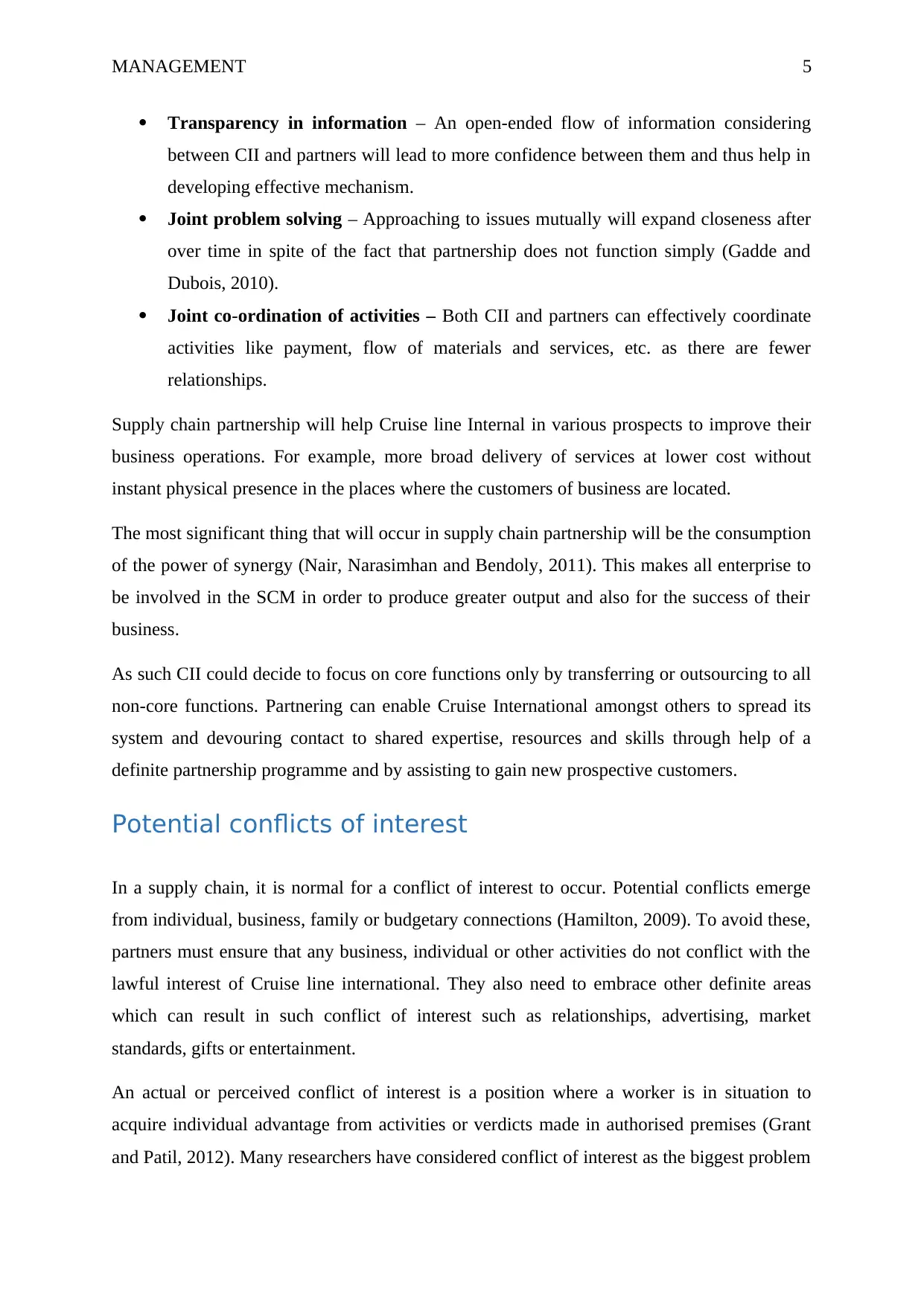
MANAGEMENT 5
Transparency in information – An open-ended flow of information considering
between CII and partners will lead to more confidence between them and thus help in
developing effective mechanism.
Joint problem solving – Approaching to issues mutually will expand closeness after
over time in spite of the fact that partnership does not function simply (Gadde and
Dubois, 2010).
Joint co-ordination of activities – Both CII and partners can effectively coordinate
activities like payment, flow of materials and services, etc. as there are fewer
relationships.
Supply chain partnership will help Cruise line Internal in various prospects to improve their
business operations. For example, more broad delivery of services at lower cost without
instant physical presence in the places where the customers of business are located.
The most significant thing that will occur in supply chain partnership will be the consumption
of the power of synergy (Nair, Narasimhan and Bendoly, 2011). This makes all enterprise to
be involved in the SCM in order to produce greater output and also for the success of their
business.
As such CII could decide to focus on core functions only by transferring or outsourcing to all
non-core functions. Partnering can enable Cruise International amongst others to spread its
system and devouring contact to shared expertise, resources and skills through help of a
definite partnership programme and by assisting to gain new prospective customers.
Potential conflicts of interest
In a supply chain, it is normal for a conflict of interest to occur. Potential conflicts emerge
from individual, business, family or budgetary connections (Hamilton, 2009). To avoid these,
partners must ensure that any business, individual or other activities do not conflict with the
lawful interest of Cruise line international. They also need to embrace other definite areas
which can result in such conflict of interest such as relationships, advertising, market
standards, gifts or entertainment.
An actual or perceived conflict of interest is a position where a worker is in situation to
acquire individual advantage from activities or verdicts made in authorised premises (Grant
and Patil, 2012). Many researchers have considered conflict of interest as the biggest problem
Transparency in information – An open-ended flow of information considering
between CII and partners will lead to more confidence between them and thus help in
developing effective mechanism.
Joint problem solving – Approaching to issues mutually will expand closeness after
over time in spite of the fact that partnership does not function simply (Gadde and
Dubois, 2010).
Joint co-ordination of activities – Both CII and partners can effectively coordinate
activities like payment, flow of materials and services, etc. as there are fewer
relationships.
Supply chain partnership will help Cruise line Internal in various prospects to improve their
business operations. For example, more broad delivery of services at lower cost without
instant physical presence in the places where the customers of business are located.
The most significant thing that will occur in supply chain partnership will be the consumption
of the power of synergy (Nair, Narasimhan and Bendoly, 2011). This makes all enterprise to
be involved in the SCM in order to produce greater output and also for the success of their
business.
As such CII could decide to focus on core functions only by transferring or outsourcing to all
non-core functions. Partnering can enable Cruise International amongst others to spread its
system and devouring contact to shared expertise, resources and skills through help of a
definite partnership programme and by assisting to gain new prospective customers.
Potential conflicts of interest
In a supply chain, it is normal for a conflict of interest to occur. Potential conflicts emerge
from individual, business, family or budgetary connections (Hamilton, 2009). To avoid these,
partners must ensure that any business, individual or other activities do not conflict with the
lawful interest of Cruise line international. They also need to embrace other definite areas
which can result in such conflict of interest such as relationships, advertising, market
standards, gifts or entertainment.
An actual or perceived conflict of interest is a position where a worker is in situation to
acquire individual advantage from activities or verdicts made in authorised premises (Grant
and Patil, 2012). Many researchers have considered conflict of interest as the biggest problem
⊘ This is a preview!⊘
Do you want full access?
Subscribe today to unlock all pages.

Trusted by 1+ million students worldwide
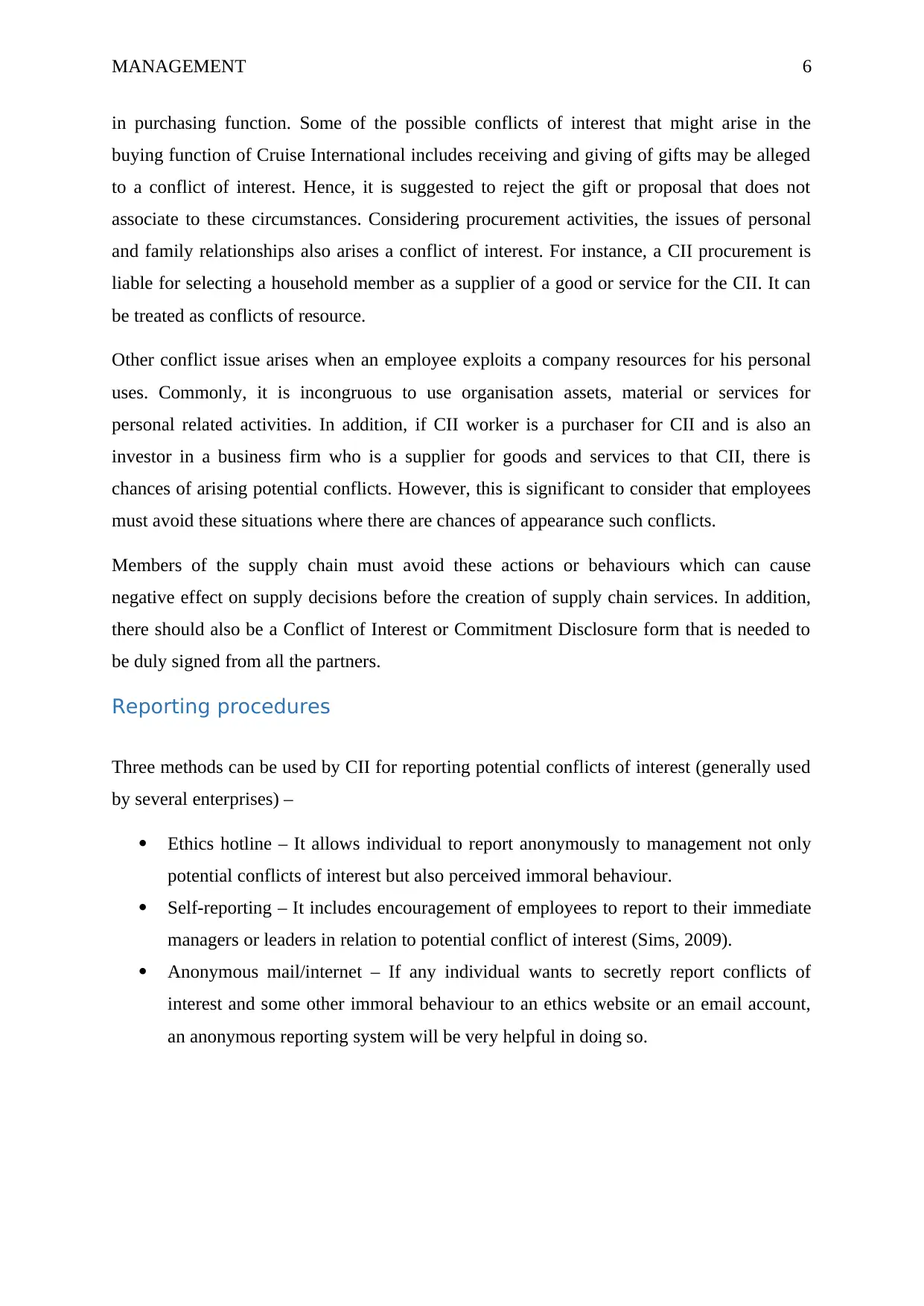
MANAGEMENT 6
in purchasing function. Some of the possible conflicts of interest that might arise in the
buying function of Cruise International includes receiving and giving of gifts may be alleged
to a conflict of interest. Hence, it is suggested to reject the gift or proposal that does not
associate to these circumstances. Considering procurement activities, the issues of personal
and family relationships also arises a conflict of interest. For instance, a CII procurement is
liable for selecting a household member as a supplier of a good or service for the CII. It can
be treated as conflicts of resource.
Other conflict issue arises when an employee exploits a company resources for his personal
uses. Commonly, it is incongruous to use organisation assets, material or services for
personal related activities. In addition, if CII worker is a purchaser for CII and is also an
investor in a business firm who is a supplier for goods and services to that CII, there is
chances of arising potential conflicts. However, this is significant to consider that employees
must avoid these situations where there are chances of appearance such conflicts.
Members of the supply chain must avoid these actions or behaviours which can cause
negative effect on supply decisions before the creation of supply chain services. In addition,
there should also be a Conflict of Interest or Commitment Disclosure form that is needed to
be duly signed from all the partners.
Reporting procedures
Three methods can be used by CII for reporting potential conflicts of interest (generally used
by several enterprises) –
Ethics hotline – It allows individual to report anonymously to management not only
potential conflicts of interest but also perceived immoral behaviour.
Self-reporting – It includes encouragement of employees to report to their immediate
managers or leaders in relation to potential conflict of interest (Sims, 2009).
Anonymous mail/internet – If any individual wants to secretly report conflicts of
interest and some other immoral behaviour to an ethics website or an email account,
an anonymous reporting system will be very helpful in doing so.
in purchasing function. Some of the possible conflicts of interest that might arise in the
buying function of Cruise International includes receiving and giving of gifts may be alleged
to a conflict of interest. Hence, it is suggested to reject the gift or proposal that does not
associate to these circumstances. Considering procurement activities, the issues of personal
and family relationships also arises a conflict of interest. For instance, a CII procurement is
liable for selecting a household member as a supplier of a good or service for the CII. It can
be treated as conflicts of resource.
Other conflict issue arises when an employee exploits a company resources for his personal
uses. Commonly, it is incongruous to use organisation assets, material or services for
personal related activities. In addition, if CII worker is a purchaser for CII and is also an
investor in a business firm who is a supplier for goods and services to that CII, there is
chances of arising potential conflicts. However, this is significant to consider that employees
must avoid these situations where there are chances of appearance such conflicts.
Members of the supply chain must avoid these actions or behaviours which can cause
negative effect on supply decisions before the creation of supply chain services. In addition,
there should also be a Conflict of Interest or Commitment Disclosure form that is needed to
be duly signed from all the partners.
Reporting procedures
Three methods can be used by CII for reporting potential conflicts of interest (generally used
by several enterprises) –
Ethics hotline – It allows individual to report anonymously to management not only
potential conflicts of interest but also perceived immoral behaviour.
Self-reporting – It includes encouragement of employees to report to their immediate
managers or leaders in relation to potential conflict of interest (Sims, 2009).
Anonymous mail/internet – If any individual wants to secretly report conflicts of
interest and some other immoral behaviour to an ethics website or an email account,
an anonymous reporting system will be very helpful in doing so.
Paraphrase This Document
Need a fresh take? Get an instant paraphrase of this document with our AI Paraphraser
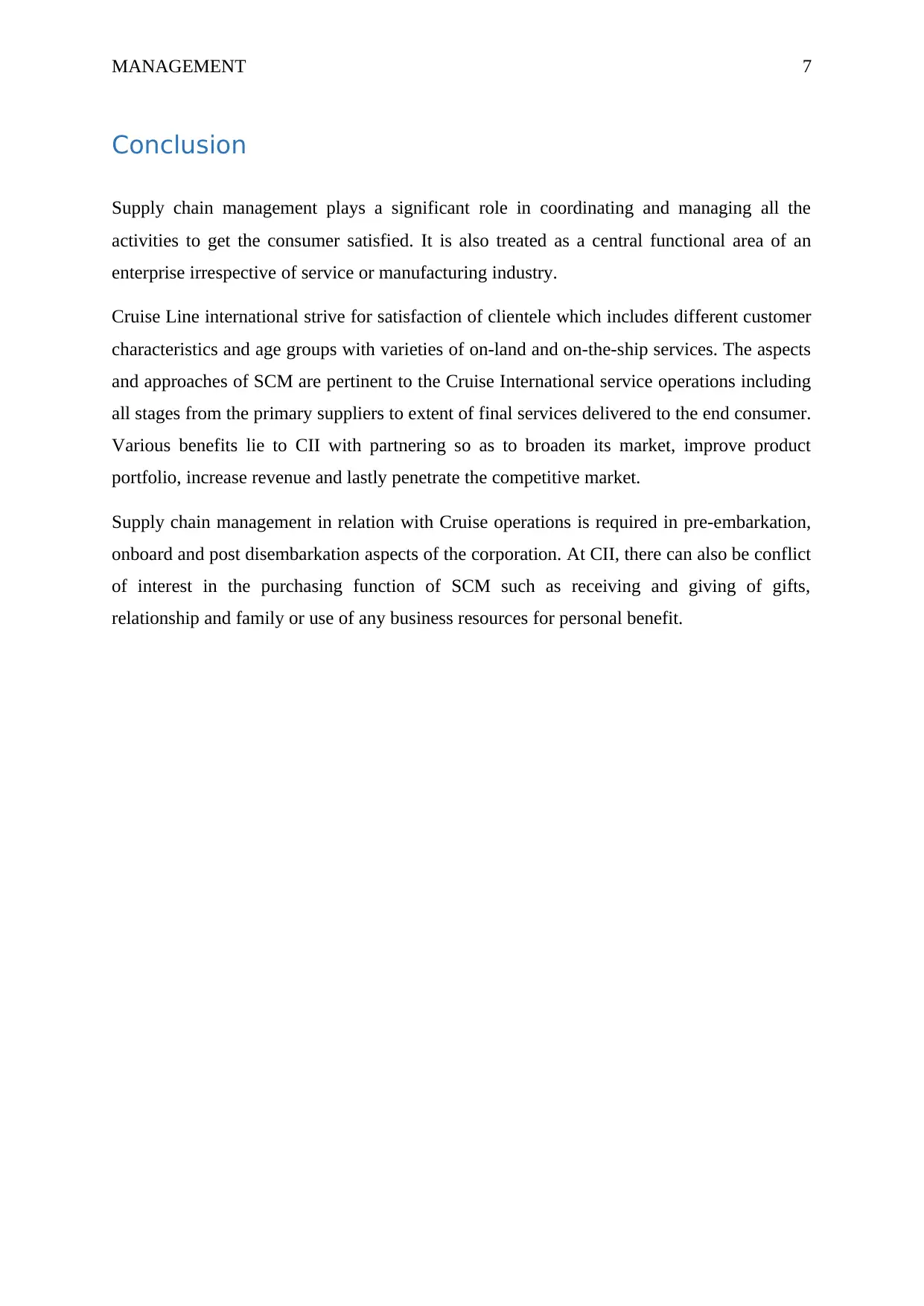
MANAGEMENT 7
Conclusion
Supply chain management plays a significant role in coordinating and managing all the
activities to get the consumer satisfied. It is also treated as a central functional area of an
enterprise irrespective of service or manufacturing industry.
Cruise Line international strive for satisfaction of clientele which includes different customer
characteristics and age groups with varieties of on-land and on-the-ship services. The aspects
and approaches of SCM are pertinent to the Cruise International service operations including
all stages from the primary suppliers to extent of final services delivered to the end consumer.
Various benefits lie to CII with partnering so as to broaden its market, improve product
portfolio, increase revenue and lastly penetrate the competitive market.
Supply chain management in relation with Cruise operations is required in pre-embarkation,
onboard and post disembarkation aspects of the corporation. At CII, there can also be conflict
of interest in the purchasing function of SCM such as receiving and giving of gifts,
relationship and family or use of any business resources for personal benefit.
Conclusion
Supply chain management plays a significant role in coordinating and managing all the
activities to get the consumer satisfied. It is also treated as a central functional area of an
enterprise irrespective of service or manufacturing industry.
Cruise Line international strive for satisfaction of clientele which includes different customer
characteristics and age groups with varieties of on-land and on-the-ship services. The aspects
and approaches of SCM are pertinent to the Cruise International service operations including
all stages from the primary suppliers to extent of final services delivered to the end consumer.
Various benefits lie to CII with partnering so as to broaden its market, improve product
portfolio, increase revenue and lastly penetrate the competitive market.
Supply chain management in relation with Cruise operations is required in pre-embarkation,
onboard and post disembarkation aspects of the corporation. At CII, there can also be conflict
of interest in the purchasing function of SCM such as receiving and giving of gifts,
relationship and family or use of any business resources for personal benefit.
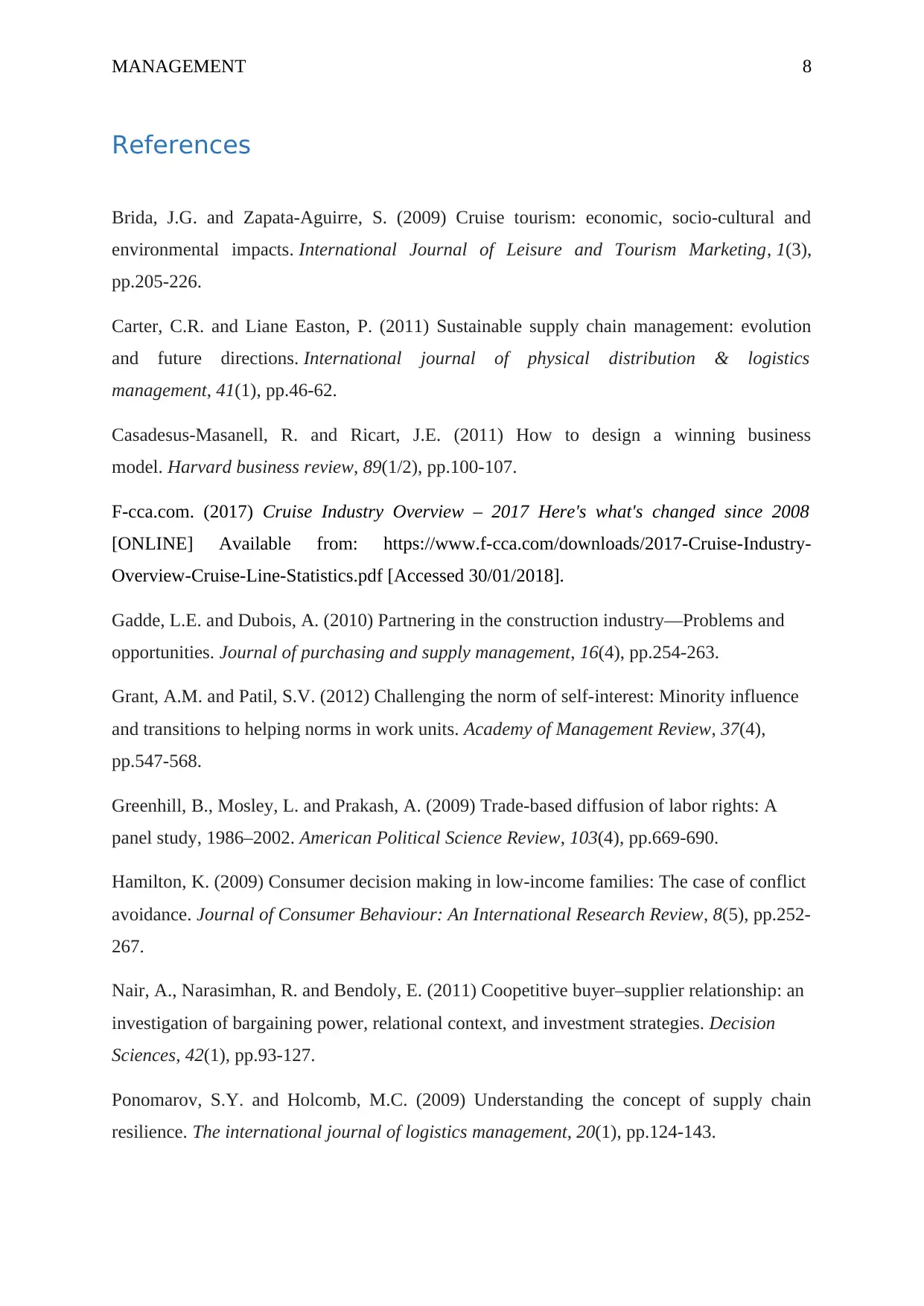
MANAGEMENT 8
References
Brida, J.G. and Zapata-Aguirre, S. (2009) Cruise tourism: economic, socio-cultural and
environmental impacts. International Journal of Leisure and Tourism Marketing, 1(3),
pp.205-226.
Carter, C.R. and Liane Easton, P. (2011) Sustainable supply chain management: evolution
and future directions. International journal of physical distribution & logistics
management, 41(1), pp.46-62.
Casadesus-Masanell, R. and Ricart, J.E. (2011) How to design a winning business
model. Harvard business review, 89(1/2), pp.100-107.
F-cca.com. (2017) Cruise Industry Overview – 2017 Here's what's changed since 2008
[ONLINE] Available from: https://www.f-cca.com/downloads/2017-Cruise-Industry-
Overview-Cruise-Line-Statistics.pdf [Accessed 30/01/2018].
Gadde, L.E. and Dubois, A. (2010) Partnering in the construction industry—Problems and
opportunities. Journal of purchasing and supply management, 16(4), pp.254-263.
Grant, A.M. and Patil, S.V. (2012) Challenging the norm of self-interest: Minority influence
and transitions to helping norms in work units. Academy of Management Review, 37(4),
pp.547-568.
Greenhill, B., Mosley, L. and Prakash, A. (2009) Trade-based diffusion of labor rights: A
panel study, 1986–2002. American Political Science Review, 103(4), pp.669-690.
Hamilton, K. (2009) Consumer decision making in low‐income families: The case of conflict
avoidance. Journal of Consumer Behaviour: An International Research Review, 8(5), pp.252-
267.
Nair, A., Narasimhan, R. and Bendoly, E. (2011) Coopetitive buyer–supplier relationship: an
investigation of bargaining power, relational context, and investment strategies. Decision
Sciences, 42(1), pp.93-127.
Ponomarov, S.Y. and Holcomb, M.C. (2009) Understanding the concept of supply chain
resilience. The international journal of logistics management, 20(1), pp.124-143.
References
Brida, J.G. and Zapata-Aguirre, S. (2009) Cruise tourism: economic, socio-cultural and
environmental impacts. International Journal of Leisure and Tourism Marketing, 1(3),
pp.205-226.
Carter, C.R. and Liane Easton, P. (2011) Sustainable supply chain management: evolution
and future directions. International journal of physical distribution & logistics
management, 41(1), pp.46-62.
Casadesus-Masanell, R. and Ricart, J.E. (2011) How to design a winning business
model. Harvard business review, 89(1/2), pp.100-107.
F-cca.com. (2017) Cruise Industry Overview – 2017 Here's what's changed since 2008
[ONLINE] Available from: https://www.f-cca.com/downloads/2017-Cruise-Industry-
Overview-Cruise-Line-Statistics.pdf [Accessed 30/01/2018].
Gadde, L.E. and Dubois, A. (2010) Partnering in the construction industry—Problems and
opportunities. Journal of purchasing and supply management, 16(4), pp.254-263.
Grant, A.M. and Patil, S.V. (2012) Challenging the norm of self-interest: Minority influence
and transitions to helping norms in work units. Academy of Management Review, 37(4),
pp.547-568.
Greenhill, B., Mosley, L. and Prakash, A. (2009) Trade-based diffusion of labor rights: A
panel study, 1986–2002. American Political Science Review, 103(4), pp.669-690.
Hamilton, K. (2009) Consumer decision making in low‐income families: The case of conflict
avoidance. Journal of Consumer Behaviour: An International Research Review, 8(5), pp.252-
267.
Nair, A., Narasimhan, R. and Bendoly, E. (2011) Coopetitive buyer–supplier relationship: an
investigation of bargaining power, relational context, and investment strategies. Decision
Sciences, 42(1), pp.93-127.
Ponomarov, S.Y. and Holcomb, M.C. (2009) Understanding the concept of supply chain
resilience. The international journal of logistics management, 20(1), pp.124-143.
⊘ This is a preview!⊘
Do you want full access?
Subscribe today to unlock all pages.

Trusted by 1+ million students worldwide
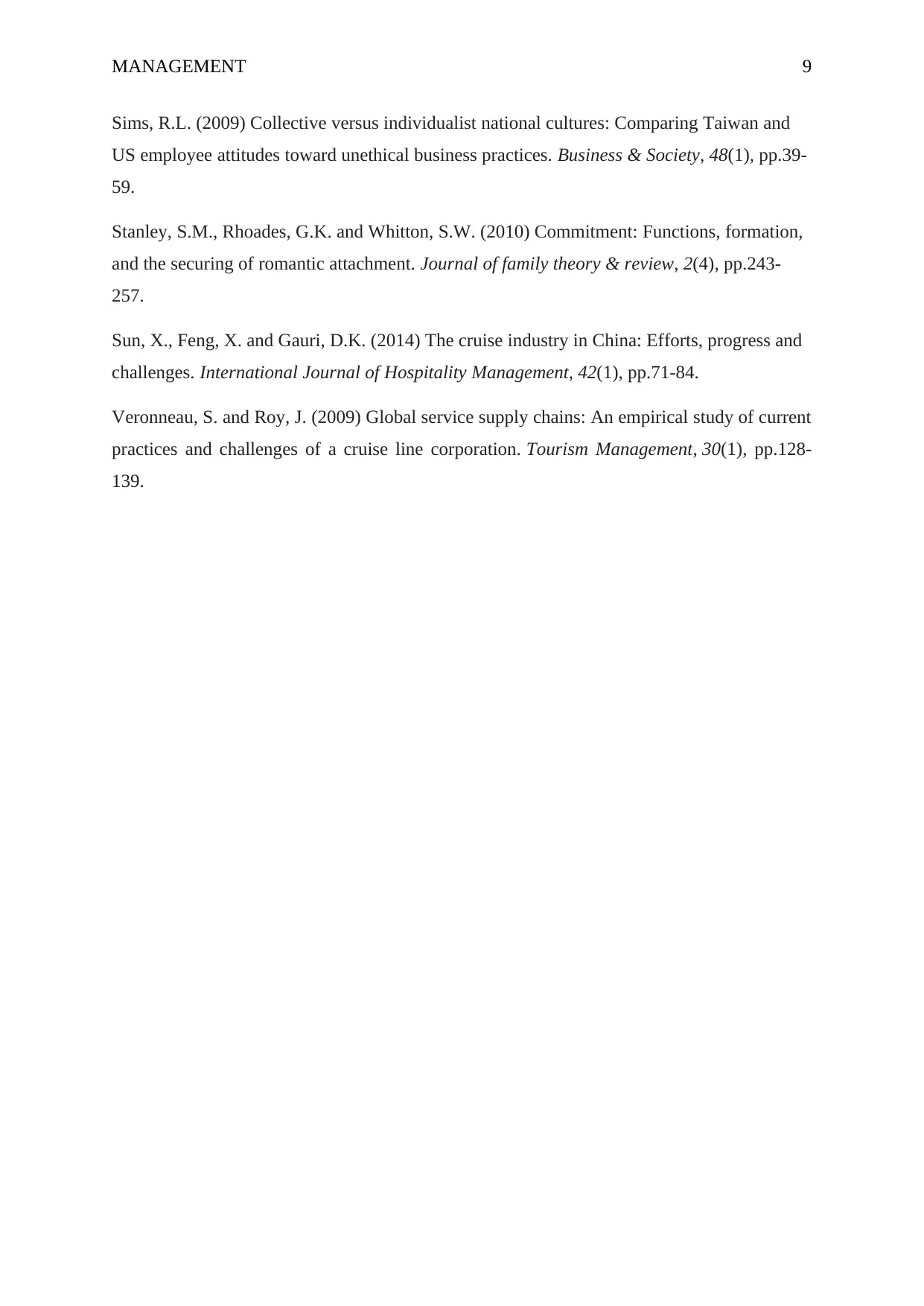
MANAGEMENT 9
Sims, R.L. (2009) Collective versus individualist national cultures: Comparing Taiwan and
US employee attitudes toward unethical business practices. Business & Society, 48(1), pp.39-
59.
Stanley, S.M., Rhoades, G.K. and Whitton, S.W. (2010) Commitment: Functions, formation,
and the securing of romantic attachment. Journal of family theory & review, 2(4), pp.243-
257.
Sun, X., Feng, X. and Gauri, D.K. (2014) The cruise industry in China: Efforts, progress and
challenges. International Journal of Hospitality Management, 42(1), pp.71-84.
Veronneau, S. and Roy, J. (2009) Global service supply chains: An empirical study of current
practices and challenges of a cruise line corporation. Tourism Management, 30(1), pp.128-
139.
Sims, R.L. (2009) Collective versus individualist national cultures: Comparing Taiwan and
US employee attitudes toward unethical business practices. Business & Society, 48(1), pp.39-
59.
Stanley, S.M., Rhoades, G.K. and Whitton, S.W. (2010) Commitment: Functions, formation,
and the securing of romantic attachment. Journal of family theory & review, 2(4), pp.243-
257.
Sun, X., Feng, X. and Gauri, D.K. (2014) The cruise industry in China: Efforts, progress and
challenges. International Journal of Hospitality Management, 42(1), pp.71-84.
Veronneau, S. and Roy, J. (2009) Global service supply chains: An empirical study of current
practices and challenges of a cruise line corporation. Tourism Management, 30(1), pp.128-
139.
1 out of 10
Related Documents
Your All-in-One AI-Powered Toolkit for Academic Success.
+13062052269
info@desklib.com
Available 24*7 on WhatsApp / Email
![[object Object]](/_next/static/media/star-bottom.7253800d.svg)
Unlock your academic potential
Copyright © 2020–2025 A2Z Services. All Rights Reserved. Developed and managed by ZUCOL.





